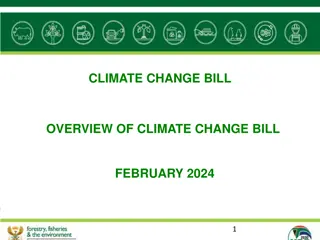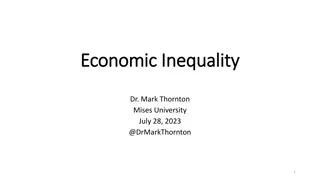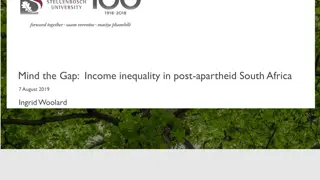Addressing Economic Inequality in the Face of Climate Change Challenges
This discussion highlights the complex issue of economic inequality within and between countries in the context of climate change. It emphasizes the importance of inclusive participation and equality in achieving the Sustainable Development Goals. Various dimensions of inequality, including economic and multidimensional aspects, are explored along with efforts to address these challenges under the UNFCCC. The role of national adaptation plans, gender equality, climate justice, and indigenous peoples' rights in combating inequality is also discussed.
Download Presentation

Please find below an Image/Link to download the presentation.
The content on the website is provided AS IS for your information and personal use only. It may not be sold, licensed, or shared on other websites without obtaining consent from the author. Download presentation by click this link. If you encounter any issues during the download, it is possible that the publisher has removed the file from their server.
E N D
Presentation Transcript
Combatting intra country and inter countries economic inequality in the context of climate change Mariama Williams, South Centre williams@southcentre.int Leaving no one behind- the role of participation and equality in implementing the Sustainable Development Goals Side Event The 39th Session of the Human Rights Council 17 September 2018 Palais des Nations
As we embark on this great collective journey, we pledge that no one will be left behind. Recognizing that the dignity of the human person is fundamental, we wish to see the Goals and targets met for all nations and peoples and for all segments of society. And we will endeavour to reach the furthest behind first . 2030 Agenda for Sustainable Development
Outline Multidimensional inequality Economic inequality SDGs and Inequality SDGs and Climate change Within country dimensions of climate change and inequality Inter countries dimensions of climate change and inequality Attempts to address inequality/economic effects of climate change in the UNFCCC: Climate Justice, Indigenous peoples, Gender Participation Mechanisms: National Adaptation Plans (NAPs) and Nationally Determined Contribution (NDCs) & the GCF, and other related mechanism proposed under the Paris Agreement
Multidimensional inequality Multi-dimensional inequality 1. inequalities based on demographic characteristics, such as gender, race, ethnicity, religion, and age. 2. A second type of in-equality is regarding assets and income. 3. inequality is regarding public decision making (political power) and access to public resources, such as public health, education, housing, and other services (Islam and Winkler 2017)
Multidimensional Inequality Economic and Political transmission channels of the effects of inequality on disadvantaged groups Climate Change and Social Inequality S. Nazrul Islam and John Winkel (2017) DESA Working Paper No. 152
Economic Inequality Economic inequality hampers the achievement of the right to development, and further diminishes the ability of marginalized sectors and communities to participate fully and effectively in the development process Economic inequality in many developing countries continues to be a major problem, as developing country governments continue to seek ways to spread the benefits of growth to their peoples. However, structural deficiencies including in relation to international-domestic trade linkages, infrastructure gaps, finance gaps, etc. continue to make it difficult for developing countries to combat economic inequality rapidly. To address economic inequality and achieve the right to development, rapid increases in income and more equitable income distribution needs to be undertaken by addressing systemic gaps and barriers. Human rights based approaches: At in country level: income guarantees, revitalised and enhance public service, universal Basic income, employment guarantees schemes, gender equality interventions, rights and economic justice for indigenous persons, programmes for persons living with disabilities, Intra country: adequate and principled ODA flows, sustainable debt management, sustainable trade, climate finance for developing countries climate actions etc. Challenges to these include: Unconventional monetary policy, e.g., quantitative easing , has also widened income and wealth gaps besides fuelling financial asset bubbles (Chowdhury and Sundaram 2018); debt accumulation (lessens fiscal and policy space to address both climate change and inequality) and fiscal austerity programmes.
The SDGs and Inequality Specific SDGs and Inequality Goal 5: gender equality Goal 10: reducing in-equalities within and among countries Targets: 5c, 10.3, 16.b the need to promote and enforce non-discriminatory laws
The SDGs, HR and Climate Change All 17 goals and 169 target to achieve them are directly and indirectly related to or impacted by climate change All are irrevocably and inextricably tied to Human rights in fact the SDGs seek to realise the human rights of all Climate change and addressing it are fundamental to the exercise of human rights, including the right to development
SDGs and Climate Change Goal 13. Take urgent action to combat climate change and its impacts Climate change people and development: rising temperatures are increasing the amount of water vapor in the atmosphere, leading to more intense rainfall and flooding in some places, and drought (Africa) in others. (Floods: across Bangladesh, India and Nepal etc.) Rising and warming seas are contributing to the intensity of tropical storms worldwide. (Category 5 hurricanes now normal occurrence Dominica, Barbuda, Puerto Rico etc.) Climate change presents the single biggest threat to development, and its widespread, unprecedented impacts disproportionately burden the poorest and most vulnerable. Urgent action to combat climate change and minimize its disruptions is integral to the successful implementation of the Sustainable Development Goals. (2030 Agenda)
Climate change targets and indicators Targets 13.1.3 Proportion of local governments that adopt and implement local disaster risk reduction strategies in line with national disaster risk reduction strategies 13.1.1 Number of deaths, missing persons and persons affected by disaster per 100,000 people 13.1.2 Number of countries with national and local disaster risk reduction strategies 13.2.1 Number of countries that have communicated the establishment or operationalization of an integrated policy/strategy/plan which increases their ability to adapt to the adverse impacts of climate change, and foster climate resilience and low greenhouse gas emissions development in a manner that does not threaten food production (including a national adaptation plan, nationally determined contribution, national communication, biennial update report or other) 13.3.1 Number of countries that have integrated mitigation, adaptation, impact reduction and early warning into primary, secondary and tertiary curricula 13.3.2 Number of countries that have communicated the strengthening of institutional, systemic and individual capacity-building to implement adaptation, mitigation and technology transfer, and development actions 13.a.1 Mobilized amount of United States dollars per year starting in 2020 accountable towards the $100 billion commitment 13.b.1 Number of least developed countries and small island developing States that are receiving specialized support, and amount of support, including finance, technology and capacity-building, for mechanisms for raising capacities for effective climate change-related planning and management, including focusing on women, youth and local and marginalized communities Indicators 13.1 Strengthen resilience and adaptive capacity to climate-related hazards and natural disasters in all countries 13.2 Integrate climate change measures into national policies, strategies and planning 13.3 Improve education, awareness-raising and human and institutional capacity on climate change mitigation, adaptation, impact reduction and early warning 13.a Implement the commitment undertaken by developed-country parties to the United Nations Framework Convention on Climate Change to a goal of mobilizing jointly $100 billion annually by 2020 from all sources to address the needs of developing countries in the context of meaningful mitigation actions and transparency on implementation and fully operationalize the Green Climate Fund through its capitalization as soon as possible 13.b Promote mechanisms for raising capacity for effective climate change-related planning and management in least developed countries and small island developing States, including focusing on women, youth and local and marginalized communities * Acknowledging that the United Nations Framework Convention on Climate Change is the primary international, intergovernmental forum for negotiating the global response to climate change.
Progress of goal 13 in 2017 Planetary warming continued in 2016, setting a new record of about 1.1 degrees Centigrade above the preindustrial period, according to the World Meteorological Organization (WMO) Statement on the State of the Global Climate in 2016. Drought conditions predominated across much of the globe, aggravated by the El Nin o phenomenon In the Statement, WMO also noted that the extent of global sea ice fell to a minimum of 4.14 million km2 in 2016, the second lowest extent on record. Atmospheric carbon dioxide levels also reached a record high of 400 parts per million that year. Mitigating climate change and its impacts will require building on the momentum achieved by the Paris Agreement on Climate Change, which entered into force on 4 November 2016. Stronger efforts are needed to build resilience and limit climate-related hazards and natural disasters. Report of the Secretary-General, "Progress towards the Sustainable Development Goals", E/2017/66
Climate change and inequality Vulnerability, risk and inequality nexus: inequality shapes vulnerability of different socioeconomic groups Adaptive capacity of lowest socio-economic classes (in the context of restricted access to resources need for responding to CC Ability/inability to build resilience and deal with loss and damage As noted by Islam and Winkler, further, inequality facilitates institutional arrangements which weigh against adaptation, particularly in terms of social security and the management of growing rates of urbanization. Combination of Climate Change and Inequality Increasingly Drives Risk (Islam and Winkler)
Climate change and disasters Climate change often exacerbates disasters. Between 1990 and 2013, more than 1.6 million people died in internationally reported disasters, with annual deaths trending upwards In 2017, many countries in Latin America, the Caribbean, South Asia, and Africa were confronted with disastrous consequences of hurricanes, floods, and droughts. Thousands of people lost their lives, while millions were displaced and were left scrambling for basic necessities, including food and water. (Christian Aid/Oxfam)
Inequality and climate change vicious cycle Inequality and climate change vicious cycle Climate Change and Social Inequality S. Nazrul Islam and John Winkel (2017) DESA Working Paper No. 152
The effects of inequality on disadvantaged groups Climate Change and Social Inequality S. Nazrul Islam and John Winkel(2017) DESA Working Paper No. 152
Inter- country inequality and climate change Economic losses from weather-related disasters (billions of dollars) and as percentage of GDP by income group, 1995- 2015. Climate Change and Social Inequality S. Nazrul Islam and John Winkel (2017) DESA Working Paper No. 152
Inter countries inequality and Climate Change The vulnerability-inequality nexus is related to the process of globalization in multiple ways Climate change is already affecting the most vulnerable countries and populations, in particular the least developed countries and the small island developing States.
Climate Change and Human Rights human rights is included in the preamble of the 2015 Paris Climate Change Agreement. the impact of disasters can be severe, stripping away livelihoods and progress on health and education economic losses from infrastructure alone can be massive impacts public services and access to basic health care,water etc.
Climate justice: Historical responsibility Indigenous Peoples Rights Gender Equality and Women s economic empowerment Climate Finance
Favourable actions towards HR in Climate policy arena UNFCCC and its Paris agreement are the legal framework for shaping climate change actions nationally and internationally now and the future. The Paris Agreement adopted in December 2015 is the first global environmental agreement to recognize that human rights obligations are an integral element of the regime it establishes. It states that Parties should, when taking action to address climate change, respect, promote and consider their respective obligations on human rights, (Knox 2018). Thus some HR activities argue that it is also a human rights treaty, in a non traditional senses: It makes an important contribution to the fulfillment of human rights. By clarifying that actions to address climate change should take human rights into account, the agreement helps to mainstream human rights norms into the ongoing implementation and evolution of the climate regime. In this respect, it sets a precedent for other international regimes as well (Knox 2018, p.)
The Paris Agreement and Climate Finance The Paris Agreement (Article 9): stipulates that developed country Parties shall provide financial resources to assist developing country Parties with respect to both mitigation and adaptation in continuation of their existing obligations under the Convention. Other Parties are encouraged to provide or continue to provide such support voluntarily. as part of a global effort, developed country Parties should continue to take the lead in mobilizing climate finance from a wide variety of sources, instruments and channels, noting the significant role of public funds, through a variety of actions, including supporting country-driven strategies, and taking into account the needs and priorities of developing country Parties. Such mobilization of climate finance should represent a progression beyond previous efforts. In addition, Article 9 states that the provision of scaled-up financial resources should aim to achieve a balance between adaptation and mitigation, taking into account country-driven strategies, and the priorities and needs of developing country Parties, especially those that are particularly vulnerable to the adverse effects of climate change and have significant capacity constraints, such as the least developed countries and small island developing States, considering the need for public and grant-based resources for adaptation.
The Paris Agreement: elements of HR/inclusive participation These are essentially around: Indigenous Peoples, Gender and Climate finance UNFCCC traditional knowledge Platform for engagement of local communities and Indigenous Peoples, Indigenous Peoples rights are not fully recognized in the final platform document of COP 23. Lima Work Programme on Gender/ the Gender Action Plan Climate finance: the Convention Developed country Parties (Annex II Parties) shall provide financial resources to assist developing country Parties in implementing the Convention. Parties have established four special funds: the Special Climate Change Fund (SCCF), the Least Developed Countries Fund (LDCF), both managed by the GEF, and the GCF under the Convention; and the Adaptation Fund (AF) under the Kyoto Protocol. These are critical for the successful achievement of both climate actions as well as the overall SDG/2030 Agenda
Participatory Mechanism National Adaptation Planning (NAP) The LDC Expert Group Technical guidelines for the NAP process for preparation of NAPs stresses the importance of multi-stakeholder participation and gender equality Nationally Determined Contribution: preparation and subsequent refining should include participatory process Provisions related to education and capacity building These are areas that the South Centre is very involved in supporting developing countries on demand.























